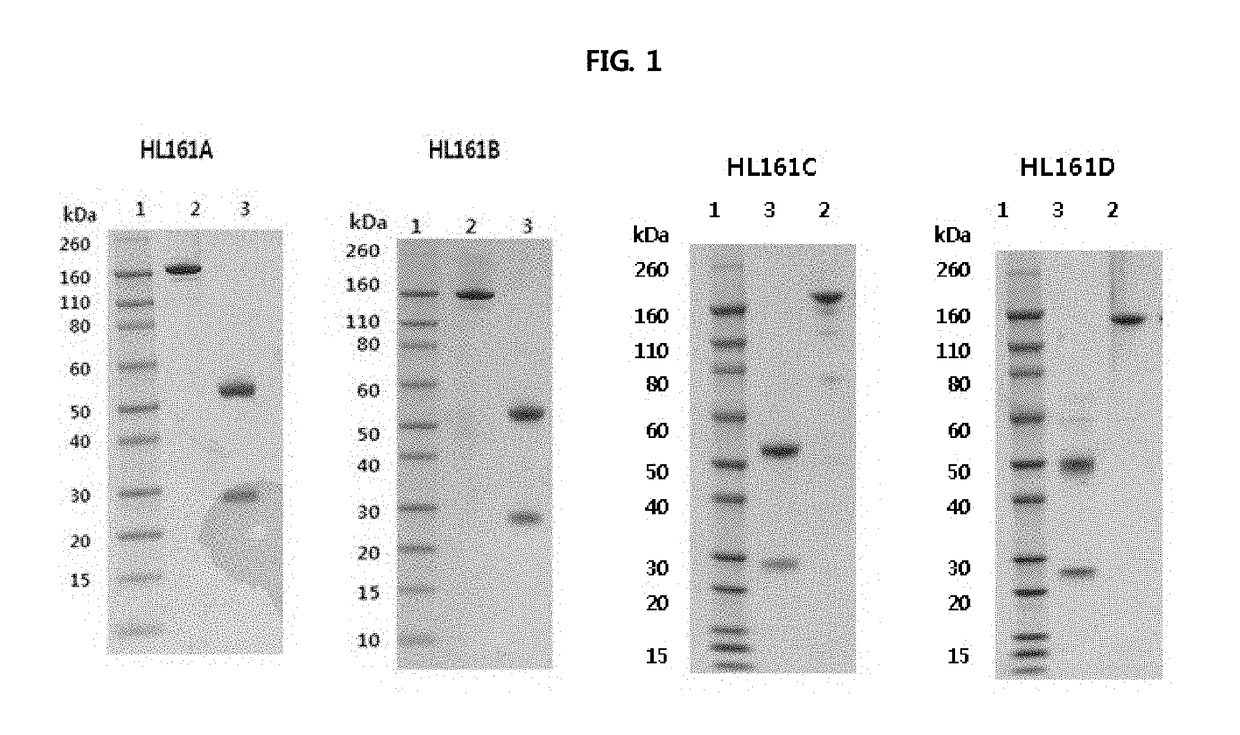Antibody binding to fcrn for treating autoimmune diseases
- Summary
- Abstract
- Description
- Claims
- Application Information
AI Technical Summary
Benefits of technology
Problems solved by technology
Method used
Image
Examples
example 1
Construction of Anti-FcRn-Expressing Library using Transgenic Rats
[0137]Immunization was performed using a total of six transgenic rats (OmniRat®, OMT). As an immunogen, human FcRn was used. Both footpads of the rats were immunized eight times with 0.0075 mg of human FcRn (each time) together with an adjuvant at 3-day intervals for 24 days. On day 28, the rats were immunized with 5-10 μg of the immunogen diluted in PBS buffer. On day 28, rat serum was collected and used to measure the antibody titer. On day 31, the rats were euthanized, and the popliteal lymph node and the inguinal lymph node were recovered for fusion with P3X63 / AG8.653 myeloma cells.
[0138]ELISA analysis was performed to measure the antibody titer in rat serum. Specifically, human FcRn was diluted in PBS (pH 6.0 or pH 7.4) buffer to make 2 μg / mL of a solution, and 100 μl of the solution was coated on each well of a 96-well plate, and then incubated at 4° C. for at least 18 hours. Each well was washed three times wit...
example 2
Evaluation of the Antigen Binding Affinity and IgG Binding Blocking Ability of Anti-hFcRn Antibodies of Hybridoma Libraries
[0140]To analyze the binding of antibodies to human FcRn, the same ELISA analysis (pH 6.0 and pH 7.4) as mentioned above was performed. The results of evaluation of the hFcRn binding of the three hybridoma libraries A, B and C indicates that the hFcRn binding affinity was higher in the order of A>C>B at both pH 6.0 and pH 7.4.
[0141]Using the culture supernatants of the three hybridoma libraries, the evaluation of the hFcRn binding affinity by FACS at 5 ng / mL and 25 ng / mL was performed at pH 6.0 and pH 7.4. Human FcRn-stable expressing HEK293 cells were detached from a flask, and then suspended in reaction buffer (0.05% BSA in PBS, pH 6.0 or pH 7.4). The suspension was diluted to a cell density of 2×106 cells / mL, and 50 μL of the dilution was added to each well of a 96-well plate. Then, 50 μL of the hybridoma library culture supernatant diluted to each of 10 ng / m...
example 3
Isolation of Hybridoma Clone by FACS and Selection of Human Antibodies
[0143]Using hybridoma library A showing the highest human FcRn binding affinity and blocking effect, clones were isolated by FACS (flow cytometry) to thereby obtain a total of 442 single clones. The isolated monoclones were cultured in HT media, and the supernatant was collected. Antibody-expressing hybridoma clones binding to hFcRn in the supernatant were selected by FACS. As a result, it could be seen that 100 clones (M1-M100) did strongly bind to the hFcRn-expressing HEK293 cells.
[0144]RNA was isolated from the 100 monoclones selected by FACS analysis and the isolated RNA was sequenced. In the first-step sequencing, 88 of the 100 monoclones were sequenced, and divided according to the amino acid sequence into a total of 35 groups (G1 to G38). The culture supernatants of the representative clones of 33 groups excluding two clones (G33 and G35) whose media were not available were diluted at a concentration of 100...
PUM
| Property | Measurement | Unit |
|---|---|---|
| Fraction | aaaaa | aaaaa |
| Molar density | aaaaa | aaaaa |
| Acidity | aaaaa | aaaaa |
Abstract
Description
Claims
Application Information
 Login to View More
Login to View More - R&D
- Intellectual Property
- Life Sciences
- Materials
- Tech Scout
- Unparalleled Data Quality
- Higher Quality Content
- 60% Fewer Hallucinations
Browse by: Latest US Patents, China's latest patents, Technical Efficacy Thesaurus, Application Domain, Technology Topic, Popular Technical Reports.
© 2025 PatSnap. All rights reserved.Legal|Privacy policy|Modern Slavery Act Transparency Statement|Sitemap|About US| Contact US: help@patsnap.com



